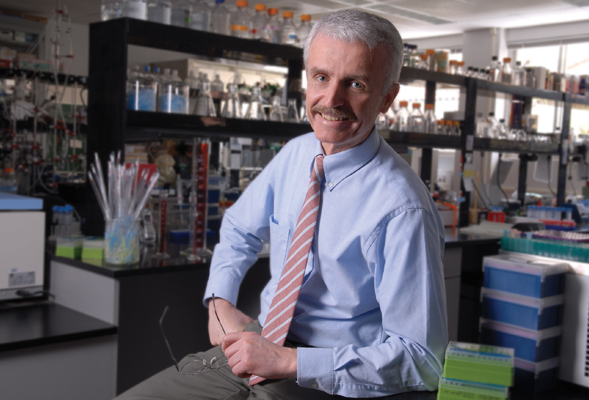
Chris Glembotski
A rare perfect score on an application for NIH funding extends work on a drug to boost the body’s natural defenses against a heart attack.
By SDSU News Team
The San Diego State University Heart Institute entered 2019 with a new $2.5 million grant from the National Institutes of Health (NIH) to take research on a possible drug treatment for heart attacks to the next level.
With promising results already seen in mice tested with the compound, molecular cardiologist and director of the SDSU Heart Institute, Chris Glembotski, and graduate students in his lab now have funding for an additional five years of work.
“In 2019 we hope to expand and extend the results that we’ve gotten so far and do studies in larger animals, (where) the hearts are more like a human heart than the mouse heart,” said Glembotski, whose grant application achieved a rare perfect score from its NIH review panel. “Once we’ve completed those studies then we’ll be ready to consider doing clinical trials.”
A paper on the team’s findings was published in Nature Communications, a prominent biomedical research journal.
Unlike some parts of the human body, such as the skin and bones, the heart does not heal if damaged.
A heart attack causes irreversible damage to the muscle of the heart, decreasing the organ’s ability to pump blood throughout the body. This decrease in heart function can be severe enough to cause death. For heart attack survivors, the impaired heart function is lifelong. That’s why it’s important to find ways to reduce the damage to the heart in those who have a heart attack.
Boosting natural resistance
Glembotski’s lab is testing a compound that could do just that. If their research results in a drug therapy, patients might be able to receive it immediately after a heart attack to boost the heart’s natural defense against the damage, decrease mortality and enhance the quality of life.
The compound works by activating ATF6, a protein in heart cells that gives the heart a sort of natural resistance to damage from myocardial infarction. The heart’s ability to activate ATF6 declines with age, however, so Glembotski’s vision is that the compound can boost the heart’s natural protective response to decrease damage to the heart.
Glembotski and his research team are investigating whether the drug candidate, administered after a heart attack, can mitigate the ensuing organ damage.
Glembotski said the compound was discovered in the collaborations of Professors Luke Wiseman and Jefferey Kelly at The Scripps Research Institute in La Jolla. They used a high throughput screening method that enabled them to rapidly test more than 600,000 compounds for their abilities to activate ATF6 in cultured cells.
The researchers found that this lone compound – out of hundreds of thousands tested – was able to activate ATF6 in the cultured cells.
“If this compound works in people as well as it did in mice, it could save many lives and improve the quality of the lives that are saved,” said Glembotski. “We are also excited about our results because we found that this compound also reduces damage to the brain in a mouse model after a stroke.”